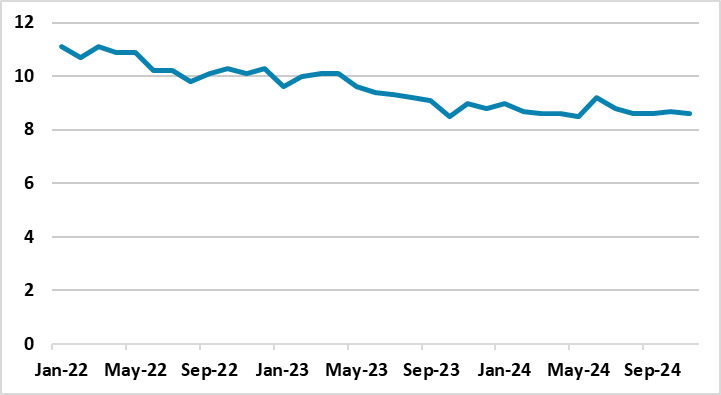Unemployment Rate Hits 8.6% in November in Turkiye
Bottom line: According to Turkish Statistical Institute’s (TUIK) figures announced on January 10, the unemployment rate declined to 8.6% in November from 8.7% in October. The number of jobless dropped 84,000 from October to 3.07 million in November, the data showed. As unemployment rate continued to edge down in November ignited by the rise in industrial production, we foresee that unemployment rate will hover around 9% in 2025 while acceleration in reverse migration by Syrian refugees could change the balances in Turkish job market, which could increase earning opportunities for Turkish citizens in the short run. We envisage that the labor shortage in Turkiye, particularly in labor-intensive sectors could increase following backward migration, which may negatively affect total production in Turkiye in the medium term while this will depend on Syrians’ preferences on returning back to Syria following the overthrow of the Assad regime in December.
Figure 1: Unemployment Rate (%), January 2022 – November 2024

Source: Continuum Economics
According to TUIK figures announced on January 10, the unemployment rate declined to 8.6% in November from 8.7% in October. The number of jobless dropped 84,000 from October to 3.07 million in November, the data showed. The employment rate for men stood at 67.1%, while for women it was 32.4%. The labor force participation rate stood at 54.2% in November, falling from 54.6% the previous month. (Note: TUIK also announced on January 10 that the industrial production index rose by 2.9% on a monthly basis in November and 1.5% YoY, supported by the fall in the unemployment rate. The headline manufacturing PMI rose to 49.1 last month from 48.3 in November, S&P Global revealed last week).
The November unemployment rate print came days after the announcement of the minimum wage increase for 2025. Net minimum wage was raised by 30% in early January, which brought net monthly pay to 22,104 TRY (USD 627). (Note: Despite the inflation hit 44.4% annually in November, it appears the hike fell short of the workers' union demand while showing government's determination to reach disinflation targets).
Commenting on the unemployment rate in November, Minister of Labor and Social Security Vedat Isikhan said "We have established our policies by evaluating global, regional and local conditions, and recorded an increase of 925 thousand people in the workforce compared to the same period in 2023. The labor force participation rate increased by 1 ppt in the same period and reached 54.2%." Treasury and Finance Minister Simsek also stated on January 10 that "Despite weak external demand conditions and the disinflation process, our policies aimed at supporting investment, employment, production, and exports have helped our economy maintain its resilience as industrial production has reached its highest level in six months."
As unemployment rate continued to edge down in November ignited by the acceleration in industrial production, we envisage that unemployment rate to hover around 9% in 2025 while acceleration in reverse migration by Syrian refugees could change the balances in Turkish job market.
After twin earthquakes hit Turkiye on February 6, 2023, Turkish citizens living in the Southern regions affected from the earthquakes mostly preferred to migrate to big cities, especially Istanbul, Izmir and Ankara. The shortage of workers in labor-intensive industries in these regions, -particularly in textiles and agriculture sectors-, was filled by Syrian immigrants who migrated to Turkish cities following Syrian civil war started.
After the overthrow of the Assad regime in Syria in December 2024, we now see some of the Syrian immigrants living in Turkey started to return to Syria. We feel reverse migration will probably accelerate after the political stability is achieved in Syria, and the labor shortage in Turkiye, particularly in labor-intensive sectors could increase following backward migration, which may negatively affect total production in Turkiye in the medium term while this will depend on Syrians’ preferences on returning back to Syria following the overthrow of the Assad regime in December.
More importantly, taking into account that Syrian refugees are overwhelmingly employed informally in Turkiye and caused a supply shock to informal labor after 2013 igniting large-scale displacement of Turkish natives in the informal sector, we think reverse migration of Syrians could increase earning opportunities for Turkish citizens as lower cost informal labor is expected to moderately diminish after Syrians will return to Syria.